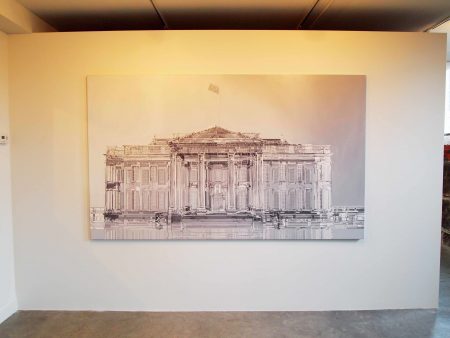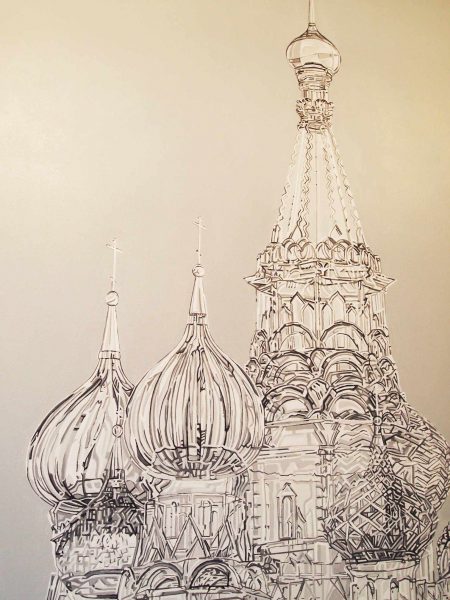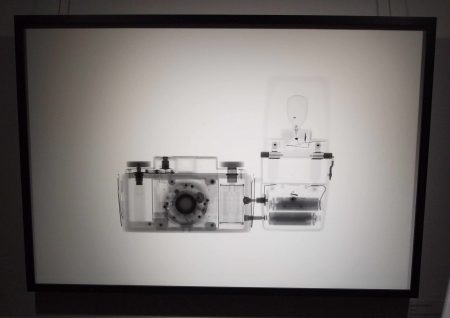
Paired with an image of the White House on a brochure, “Transparent?” is a pointed question. And, in 2018, it can take as little as a cursory glance at Twitter to feel like we might be seeing too much of our commander-in-chief’s inner dialogue. But of course, true transparency in government institutions is a phantom. The work by Cuban artists Lidzie Alvisa and Donis Llago in “Transparent?”, up through June 23 at A R E A in Boston’s South End, are not only about unhealthy governance, but confronting how we ourselves are seen.
Logistically speaking, A R E A is a welcome respite from the artful chaos of the SoWa Market (every Sunday through October), as long as you make a point of venturing down some stairs to the very end of a hallway of other galleries. But it’s the work that makes it a must-visit. Catching sight of Llago’s paintings at the entrance is like pressing your cheek against a smooth, shaded concrete wall: startling and soothing all at once.
These pieces explore transparency in different ways: Llago’s paintings depict global landmarks of governance as transparent—glass houses, if you will—while Alvisa’s hanging sculptures use mirrors and pins, forcing viewers to incorporate themselves into the work. The artists conceived these pieces independently, but the color scheme, or lack-of-color scheme, and thematic threads of transparency and reflection work together perfectly. The two are a couple, though, so it’s hardly surprising that their inspiration runs on a similar wavelength.
That wavelength addresses a tumultuous political past and present, rife with corruption and distinctive lack of transparency. Both artists live and work in Havana, Cuba, but despite two Cuba-focused paintings, “Transparent?” presents a global commentary, quite literally in terms of Llago’s governmental buildings, and thematically in Alvisa’s mirrors.
The aspect of reflection is present in every piece in the gallery, suggesting that your touch would leave earth-shattering fingerprints, or send ripples radiating over the surface. It’s enough to make you want to step lightly, to glide through their coolness in the garden-level gallery. But the message isn’t too slippery to grasp, not when Alvisa is literally spelling out “EGO” and “REFLECTION” on her mirrors, or Llago is painting some of the world’s most famous buildings. I didn’t expect to have such a visceral reaction to a show that appears, on its slick surface, to be so understated.

Llago aims to present transparency as “the ideal architecture of political power”—without showing us what’s inside those hollow halls. His paintings achieve an air of minimalism and clean messaging, while bolding confronting the viewer with their size and detail. The most intricacies of these familiar architectures are masterful, while the grayscale color scheme evokes a cool reflective image, a wish for clear glass where obstruction literally lives. He almost reduces these strongholds to paper models, with none of their dullness. While color would elevate these buildings, their blankness, even with a sheen, highlights their emptiness, suggesting a void of conscience. And even though dictators and fascists tend to embrace a bigger-the-better mentality, the large size of the paintings only emphasizes the absence of transparency within these walls.
There are more locations in Llago’s series, but curator David Guerra specifically chose the White House, the Kremlin, and the Plaza de la Revolución for this exhibition. Llago’s fourth painting at A R E A plays on the same themes of transparency, showing a Cuban and America flag waving over top of each other, adjacent but unjoined. There’s an illusion of unity, particularly given the new, precarious allowances between the two nations. Fluidly waving in an invisible wind, the flags appear to almost embrace—yet one can easily imagine them snapping back into formation, rigidly separate as ever.

If Llago’s paintings are tastefully deserted islands, Alvisa’s sculptures are the deep pools running between them. After all, most of them use mirrors as a canvas. What’s most interesting about Alvisa’s work here is her use of pins, a material that has been significant throughout her career. In her mirror series (three of the works), silver flat-head pins are held to the glass with magnets, forming what appear to be tangled clumps of metal against the metallic shine of the mirror.
The mirrors are unremarkable besides this adornment, but the choice of pins, held up by magnets, produces an unsteady feeling—like they could fall away at any second if jostled incorrectly. The pins should be penetrating something; lying in clumps is not their natural state. In using them as materials in this way, Alvisa robs them of their defining function. Even if the words they’re spelling out against the reflective surface—EGOISM and REFLECTION—are somewhat obvious, the function of the pins are not, and that’s jarring in an effective way. The mirrors reflect not only the viewer, but Llago’s paintings, presenting a curatorial opportunity that Guerra does not waste.

Alvisa’s “Rhythms” series does not employ mirrors, but uses pins to evoke what could be sound waves, or earth tremors. A strip of matting forms the “waves” within the piece, with pins puncturing it, all pointing downward. The pins are not perfectly level with each other, though, creating a subtle wave of unrest within each arrangement. Working on this meticulous scale makes the smallest detail resonate. Although not as in line with the transparency theme, they are tonally and materially at home in the exhibition, serving as a connector between the gallery’s two partitioned areas.
Another exhibition that opened recently, “Speciation: Still a Camera” at Panopticon Gallery (housed in Hotel Commonwealth in Kenmore Square), begs comparison to this exhibition both conceptually and aesthetically: it features 23 x-ray photos of cameras through the ages by AEQAI’s own Ken Krugh, the oldest model being the Rochester Camera Company Cycle Poco #3 from 1896. The camera, used as an eye to permanently capture moments, is in itself revealed, the black box of its innards invaded by the x-ray.

A more technically-minded photographer or historian may be able to pick out the evolutionary points of the machinery, but the photos are interesting to the casual viewer, too (and oh-so-marketable, with a neat poster on sale). What I found most interesting was that the captions noted what general populations appreciated each camera in its heyday. One was “popular with young people and beginners,” another was the same model that was used to photograph Marilyn Monroe and Betty Page, another was appreciated by servicemen visiting their families while on leave during WWII and the Korean War.
It’s that aspect of personalization, beyond the black and white see-through aesthetic, that makes me tie these two exhibitions together. “Transparent?” invites us to examine ourselves, through the examination and exposure of global power structures. “Speciation” reveals cameras’ insides, but in a way that pays homage to the people who use them. Whether it’s a paintbrush, x-ray, or mirror, those in power would do well to check their reflection, as the citizen-viewer does the same.